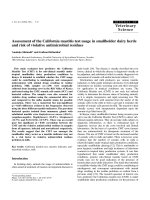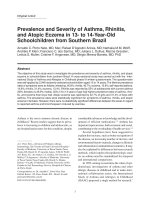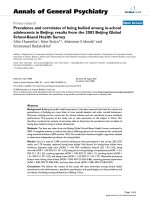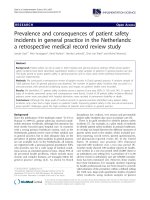Prevalence and detection of subclinical mastitis by california mastitis test (CMT) in dairy farms of Theni district in Tamil Nadu, India
Bạn đang xem bản rút gọn của tài liệu. Xem và tải ngay bản đầy đủ của tài liệu tại đây (154.44 KB, 6 trang )
Int.J.Curr.Microbiol.App.Sci (2020) 9(7): 988-993
International Journal of Current Microbiology and Applied Sciences
ISSN: 2319-7706 Volume 9 Number 7 (2020)
Journal homepage:
Original Research Article
/>
Prevalence and detection of Subclinical Mastitis by California Mastitis Test
(CMT) in Dairy Farms of Theni District in Tamil Nadu, India
A. Senthilkumar*, S. Murugesan and P. Balamurugan
Farmers Training Centre, Tamil Nadu Veterinary and Animal Sciences University,
Theni-625531, India
*Corresponding author
ABSTRACT
Keywords
CMT Kit-Dairy
cattle-Subclinical
mastitis-Prevalence
Article Info
Accepted:
11 June 2020
Available Online:
10 July 2020
The present investigation was carried out during the front line demonstration
programme conducted at ten villages in Theni District of Tamil Nadu. A total 120
milk samples from 30 cows were screened by Modified California Mastitis Test
for identification of subclinical mastitis. Out of 120 milk samples, about 24 milk
samples were positive for subclinical mastitis while 96 milk samples observed to
normal. Totally 120 samples were screened 13 samples as1+,8 samples as 2++ and
3 samples as 3+++ out of 24 subclinical mastitis affected milk samples. On the
basis of stage of lactation wise early, mid and late stage of lactation, the
prevalence of subclinical mastitis was 28.57%;16.67% and 16.67% respectively.
The quarter wise, right forequarter, right hindquarter, left forequarter and left
hindquarter, the prevalence of subclinical mastitis was 16.66%;54.17%;8.33% and
20.83% respectively. On the basis of parity, from first to fourth parity, the
prevalence of subclinical mastitis was 9.09%;16.66%;25.00% and 25.00%
respectively. CMT is a reliable diagnostic method in field conditions.
Subclinical mastitis can only be demonstrated
using various tests such as California Mastitis
Test (CMT), Whiteside test (WST), Surf field
mastitis test (SFMT), Sodium Lauryl Sulphate
test (SLST), Microscopic Somatic Cell Count
(MSCC) (Sharma et al., 2010 and Hoque et
al., 2014) and Electrical Conductivity (EC)
(Hegde et al., 2013).
Introduction
Mastitis is defined as inflammation of
mammary gland. It is divided into two types:
clinical and subclinical. Clinical mastitis is
easy to detect (seeing clotted milk or changes
in milk). But Subclinicalmastitis is
asymptomatic; therefore, produced milk
appears to be normal. It is now a well-known
fact that the subclinical mastitis is more
serious and is responsible for much greater
loss to the dairy industry (Miller et al., 1993).
Enzymatic analyses such as colourimetric and
fluorometric assays have also been developed
(Viguier et al., 2009).
988
Int.J.Curr.Microbiol.App.Sci (2020) 9(7): 988-993
New advanced techniques such proteomics
have been recently developed and used in
detection of proteins involved in mastitis
(Lippolis and Reinhardt, 2005;Van Leeuwen
et al., 2005 and Smolenski et al., 2007). Most
of these tests are preferred as screening tests
indicating SCM since they are easy to use and
yield rapid as well as satisfactory results.
However, CMT has been recognized as a
reliable, highly sensitive, inexpensive rapid
screening test in field conditions even by less
trained dairy men based upon the amount of
cellular nuclear protein present in the milk
sample (Joshi and Gokhale,2006 and
Madut,2009).The present study was to
investigate the prevalence of subclinical
mastitis in dairy cows of Theni district by
using field test i.e. California Mastitis Test.
consider the mammary quarter as positive to
CM and was excluded from the study
.Subclinical mastitis prevalence was obtained
by the use of California Mastitis Test (CMT)
which was conducted using scores from 0 to 4
from the modified Scandinavian scoring
system, where 0 is negative result (no gel
formation), 1 istraceable (possible infection),
and 2 or 3 indicates a positive result and 4 has
the thickest gel formation. Milk samples were
collected from all four quarters and
individually analysed with CMT to detect
SCM, as previously described (Quinn et al.,
2011).After confirming SCM by CMT, the
udder and teats were cleaned with water and
wiped using sterile towels. The teat orifice
and the skin around the teat were dipped with
KMnO4 and dried off with sterile towels.
Materials and Methods
2ml of milk from each quarter was taken into
the respective four cups of CMT paddle. An
equal amount of above CMT reagent was
added in each cup and gently mixed and
rotated anticlockwise for few seconds and
result was recorded within 30 seconds as 0
(negative),T(trace(,1+,2++ or 3+++ as per
manufacture instructions..
The present investigation was carried out
during the front line demonstration
programme conducted at ten villages in Theni
District of Tamil Nadu during the period from
2018 to 2019.Totally 30 crossbred dairy cows
(Jersey / HF) of different age groups (3-6
years), different parities (1-4) and different
stage of lactation (Early, mid and Late) were
included in the investigation study group. All
cows were stall fed and milked twice daily by
hand milking. The regular practices of
washing of udder before milking with clean
water were used by milking man.
Results and Discussion
In the present investigation, a total 120 milk
samples from 30 cows were screened by
modified California mastitis test for
identification of subclinical mastitis. Out of
120 milk samples, about 24 milk samples
were positive for subclinical mastitis while 96
samples observed to normal. The positive
samples were graded into three grades as per
their grading i.e.1+ traceable(possible
infection),2++(distinct
positive)
and
3+++(strong positive).Totally 120 samples
were screened 13 samples as1+,8 samples as
2++ and 3 samples as 3+++ out of 24
subclinical mastitis affected milk samples.
The overall animal and breed like Jersey and
HF wise, the prevalence of subclinical
California mastitis test and detection of
scm
Prior to milk collection for mastitis screening,
clinical examination was performed on the
every lactating cow. Thorough palpation of
the udder to detect any fibrosis, swelling, and
other clinical signs was performed. Watery
milk, milk with pus or clots, and blind
quarters were also examined. Identification of
at least one of these signs was enough to
989
Int.J.Curr.Microbiol.App.Sci (2020) 9(7): 988-993
mastitis was 30.00%;10.00% and 25.00%
respectively. On the basis of stage of lactation
wise early, mid and late stage of lactation, the
prevalence of subclinical mastitis was
28.57%; 16.67% and 16.67% respectively.
The quarter wise, right forequarter, right
hindquarter, left forequarter and left
hindquarter, the prevalence of subclinical
mastitis
was16.66%;54.17%;8.33%
and
20.83% respectively. On the basis of parity,
from first to fourth parity, the prevalence of
subclinical
mastitis
was
9.09%;
16.66%;25.00% and 25.00% respectively
Which was close to in agreement with Sudhan
et al., (2005) and Badiuzzaman et al., (2015)
reported that the right hindquarter was more
significantly (p<0.001) susceptible to
subclinical mastitis than other quarters. Cows
with third and fourth parity and at their early
stage of lactation had significantly higher in
prevalence of subclinical mastitis. This
observation supports with the reports of
Joyoti et al., (1998) who reported 77.77%,
63.76% and 41.00% prevalence of subclinical
mastitis in early, mid and late stage of
lactation respectively. Rahman et al., (1997)
reported that highest prevalence of subclinical
mastitis during the third months (34.00%)
lactation. Lalrintluanga et al., (2003) reported
that mastitis incidence was higher during the
early stage of the third lactation(36.60%).
The result regarding animal wise prevalence
of present investigation was close to in
agreement with Lahamge et al., (2019) who
reported that the prevalence of subclinical
mastitis in dairy cows was 33.30%. But
slightly lower than report of Swami et al.,
(2017). He found that the prevalence of
subclinical mastitis in dairy cows was
35%.Varatanovic et al., (2015) and Bonde et
al., (2014) reported that 60.00% and 56.02%
the prevalence of subclinical mastitis in dairy
cows respectively which was higher that of
result of present investigation.
However, somatic cell count is found out to
increase in first few days of lactation and may
be high up to the first month of lactation
(Atakan,2008) and increase towards the end
of lactation is considered to be physiological.
Sederevicius et al., (2006) reported a
temporary increase in somatic cell count just
after calving due to adaptation of the udder
from non-lactating to lactating status, while in
mid lactation somatic cell count usually
remains in normal range.
The result of present investigation the
prevalence of subclinical mastitis regarding
grade wise in dairy cows was close to in
agreement with Kasikei et al., (2012)
evaluated total 386 milk samples from
quarters of 188 cows out of that
258(66.85%),85(22.02%)and
43(11.13%)
milk samples as CMT(+), CMT(++), CMT
(+++) respectively. But lower than result of
Risvanli and Kalkan (2002) whose reported
out of 271 subclinical mastitis quarter 8.12%,
22.88% and 69.00% of quarter positive for
CMT (+), CMT(++),CMT(+++) respectively.
The result of present investigation the right
hindquarter was more susceptible than other
quarters. Cows with third and fourth parity
and early stage of lactation were more
susceptible subclinical mastitis than others.
The CMT test showed higher prevalence rate
of subclinical mastitis than other test. For
identification of subclinical mastitis CMT test
was considered as good test and most accurate
test diagnostic technique (Schalm et al.,
1971). The variation of prevalence might be
attributed to various factors i.e. age, breed,
lactation period, season etc. Kurjogi and
Kaliwal (2014) also has reported that age,
lactation period of the cow and environmental
factors could be directly associated with the
subclinical mastitis, whereas, clinical mastitis
is more associated with the breed of the cow
and environmental conditions.
990
Int.J.Curr.Microbiol.App.Sci (2020) 9(7): 988-993
Table.1 Prevalence of subclinical mastitis
Particulars
No. of Animals
CMT Test
CMT Grade
Jersey
HF
Early lactation
Mid lactation
Late lactation
Right forequarter
Right hindquarter
Left forequarter
Left hindquarter
First parity
Second parity
Third parity
Fourth parity
Numbers
30
120 milk
samples
24
Positive
6
24
13 samples 1+
(54.16%)
10
20
14
6
4
24
24
24
24
11
6
8
5
1
5
4
1
1
4
13
2
5
1
1
2
2
Similarly, Ranjan et al., (2011) also has
reported change in occurrence of bovine
mastitis under different climatic conditions.
The results of this current study concur with
other recent trials that the CMT has the
potential to be a rapid, accurate, and
economically feasible test for fresh cows.
There remains a definite need for cow-side
test procedures that could be used on CMT
positive quarters to identify specific
pathogens.
Negative
24
96
8 samples 2++
(33.33%)
9
17
10
5
3
20
11
22
19
10
5
6
3
Percentage
30.00
30.00
3 samples
3+++
(12.50%)
10.00
25.00
28.57
16.67
16.67
16.66
54.17
8.33
20.83
9.09
16.66
25.00
25.00
Lactating Cows: Comparison of Four
Screening Tests And Effect Of Animal
Factors On Its Occurrence.Bangladesh
Journal
of
Veterinary
Medicine 13(2):41.
Bonde, S. W., Gaikwad, N. Z., Ravikanth, K.,
Thakur, A., and Maini, S., 2014. Effect
of
Herbal Topical Gel (Mastilep)
application on the LDH activity and
Total Immunoglobulin Levels in milk
from cows suffering with Subclinical
Mastitis. The Journal of Veterinary
Science, Photon, 115: 370-376.
Hegde,R.,Isloor,S.,Prabhu,K.N., et al., 2013.
Incidence of subclinical mastitis and
prevalence of major mastitis pathogens
in organized farms and unorganized
sectors. Indian Journal of Microbiology,
53(3):315–320
Hoque,M.N.,Das,
Z.
C.,Talukder,A.
K.,Alam,M. S and. Rahman,A. N. M.
A.,2014. Different screening tests and
References
Atakan, K.O.C., 2008. A study of somatic cell
counts in the milk of Holstein-Friesian
cows managed in Mediterranean
climatic condition. Turkish Journal of
Veterinary and Animal Sciences 32: 1318.
Badiuzzaman,M.,,Samad,A., Siddiki,S and
Md.T.Islam,2015.Subclinical Mastitis in
991
Int.J.Curr.Microbiol.App.Sci (2020) 9(7): 988-993
milk somatic cell count for the
prevalence of subclinical bovine
mastitis in Bangladesh, Tropical Animal
Health and Production,47(1): 79–86.
Joshi,S.,
andGokhale,S.,2006.Status
of
mastitis as an emerging disease in
improved and periurban dairy farms in
India, Annals of the New York Academy
of Sciences, 1081:74–83.
Joyoti,B., Dutta, G.N and Buragohain,
J.,1998.Control of bovine mastitis
through treatment of subclinical mastitis
during lactation. Indian journal Dairy
Science 51: 309-314.
Kasikci, G., Cetin, O., Bingol, E. B., and
Gunduz, M. C.,2012.Relations between
electrical conductivity, somatic cell
count, California mastitis test and some
quality parameters in the diagnosis of
subclinical mastitis in dairy cows.
Turkish journal of veterinary and
animal sciences, 36(1): 49-55.
Kurjogi, M., and Kaliwal, B. B., 2014.
Epidemiology of Bovine Mastitis in
Cows
of
Dharwad
District.
International
Scholarly
Research
Notices, 1-9.
Lahamge,M. S.,Thakre,A.,Bonde S. W.,
Borkar, S. D.,Somkuwar,A. P. and Patil,
D. V., 2019.Prevalence of Subclinical
Mastitis in Cows: In and Around
Nagpur
Region.
Int.J.Curr.Microbiol.App.Sci.,
8(12):
83-88.
Lalrintluanga. C., Ralte, E.C and Hmarkunga,
2003.
Incidence
of
mastitis,
bacteriology and antibiogram in dairy
cattle in Aizawl, Mizoram. Disease
Investigation Laboratory, AH and
Veterinary Department, Mizoram, India.
Indian Veterinary Journal 80: 931-932.
Lippolis,J. D. and Reinhardt,T. A.,2005.
Proteomic survey of bovine neutrophils,
Veterinary
Immunology
and
Immunopathology, 103(1-2):53–65.
Miller, G.Y., Bartlett,.P,C., Lance S.E.,
Anderson, J and Heider, L.E.,
1993.Costs of clinical mastitis and
mastitis prevention in dairy herds.
Journal of the American Veterinary
Medical Association 202: 1230-1236
Quinn,P. J., Markey,B. K., Leonard,F. C.,
Fitzpatrick,E. S, Fanning,S. and
Hartigan,P.
J.,2011.Veterinary
Microbiology and Microbial Disease,
Blackwell Science Ltd.
Rahman,M..S., Nooruddin, M and Rahman,
M.M., 1997.Prevalence and distribution
of mastitis in cross-bred and exotic
dairy cows. Bangladesh Veterinary
Journal 14: 1-4.
Ranjan, R., Gupta, M. K., and Singh, K. K.,
2011. Study of bovine mastitis in
different
climatic
conditions
in
Jharkhand, India. Veterinary world,
4(5): 205-208.
Risvanlı, A., and Kalkan, C., 2002. The effect
of age and breed on somatic cell count
and microbiological isolation rates in
milk of dairy cows with subclinical
mastitis. Yuzuncu Yil Universitesi,
Veteriner Fakultesi Dergisi, 13: 84-87.
(in Turkish with summary in English).
Schalm, O. W., Caroll, G., and Jain, N.C.,
1971.Bovine Mastitis. Lea and Febiger
Philadelphia Pa, USA, 95- 127.
Sederevicius A, Balsyte J, Lukauskas K,
Kazlauskaite J and Biziulevicius, G.A.,
2006. An enzymatic cow immunitytargeted approach to reducing milk
somatic cell count: A comparative field
trial.
Food
and
Agricultural
Immunology 17: 1-7.
Sharma,N.,Pandey,V and Sudhan,N.A.,2010.
Comparison of some indirect screening
tests for detection of subclinical mastitis
in dairy cows, Bulgarian Journal of
Veterinary Medicine, . 13(2): 98–103.
Smolenski, G., Haines,S., F. Y.-S.
Kwan,F.Y.S.,2007.
et
al.,
Characterisation of host defence
proteins in milk using a proteomic
992
Int.J.Curr.Microbiol.App.Sci (2020) 9(7): 988-993
approach,
Journal
of
Proteome
Research, 6(1):207–215.
Sudhan, N.A., Singh, R., Singh, M and
Soodan, J.S., 2005. Studies on
prevalence, etiology and diagnosis of
subclinical mastitis among cross bred
cows. Indian Journal of Animal
Research 39: 127-130.
Swami, S.V., Patiland, R.A., and Gadekar,
S.D., 2017. Study on prevalence of
Subclinical mastitis in dairy animals.
Journal of entomology and zoology
studies, 5(4): 1297-1300.
Van
Leeuwen,W.
B.,Melles,D.
C.,Alaidan,A.,2005. et al., Host and
tissue-specific pathogenic traits of
Staphylococcus aureus, Journal of
Bacteriology,187(13):4584–4591.
Varatanovic, N., Cengic, B., and Imsirevic,
E., 2015. Research on subclinical
mastitis and it‟sethiological in different
breeds of cow. Biotechnology in
Animal Husbandry, 31(3): 365-374.
Viguier,C.,Arora,S.,Gilmartin,N.,Welbeck,K
and
Kennedy,R.O.,2009.
Mastitis
detection: current trends and future
perspectives, Trends in Biotechnology,
27( 8):486–493.
How to cite this article:
Senthilkumar. A., S. Murugesan and Balamurugan. P. 2020. Prevalence and detection of
Subclinical Mastitis by California Mastitis Test (CMT) in Dairy Farms of Theni District in
Tamil Nadu, India. Int.J.Curr.Microbiol.App.Sci. 9(07): 988-993.
doi: />
993









